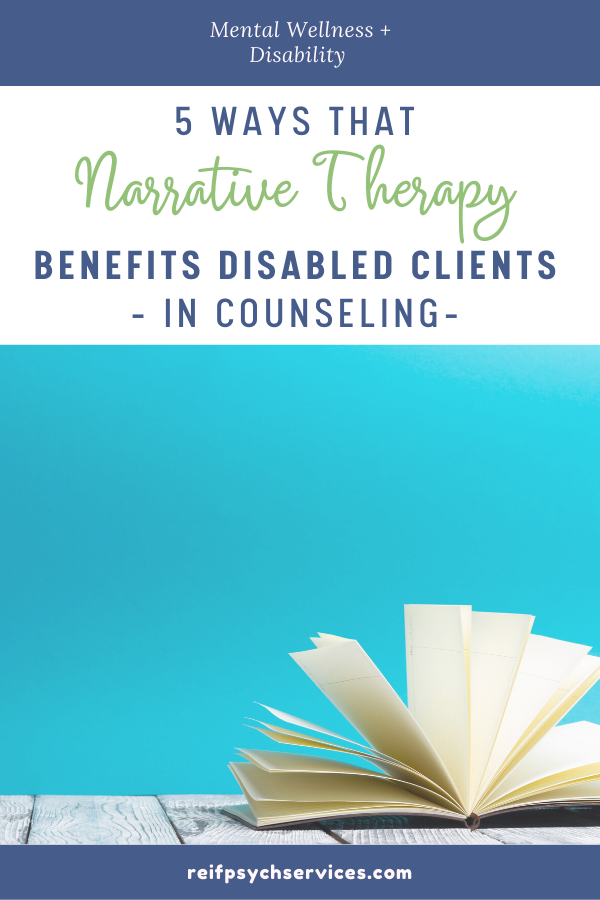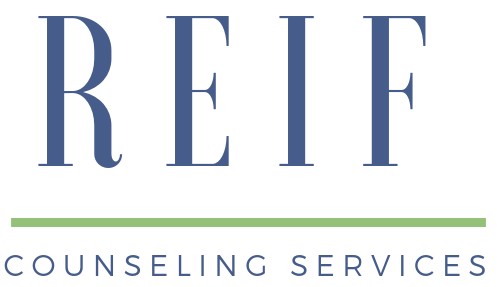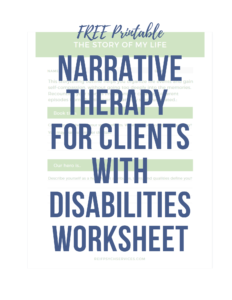When I meet with counseling clients who have recently become disabled, I often encourage them to focus on their story.
After a traumatic or disabling event, clients can struggle to find resilience, purpose, or meaning.
Through narrative therapy, clients can learn to challenge the familiar stories that keep them stuck. Together, we can help them develop a new understanding of who they are, and how their disability affects them.
Read on to learn more about narrative therapy for counseling clients with disabilities. I’ll share 5 specific ways that disabled clients benefit from narrative therapy.
There’s even a free printable worksheet to help you rewrite your own story!

1. Uncovering plot themes
During my first meeting with a disabled client, they’ll tell me about the concerns and incidents that have brought them to counseling.
I listen closely as the client shares stories and vignettes from their life. I’m trying to recognize any themes or parallels that may be present.
Of course, the client tells their story from their perspective. What they say and how they say it influenced by their values and beliefs.
During this initial phase, my role as the counselor is to serve as an editor to the story they are authoring. I ask my clients questions to help them write a clearer version of their own story.
Are there certain characters who are getting too much attention? Are there certain details that it would be helpful to explore further?
These are the kinds of questions I ask my client, to help them also recognize any themes or common plots in the version of the story they are sharing.
2. Identifying the real problem
It’s common for clients to tell stories in which they are the problem. I encourage my clients who have acquired disabilities to separate themselves from their problem.
In this way, clients develop a new relationship with the problem. They see that they are not the problem. The problem is the problem. They are now able to solve the problem.
Using externalizing questions and language can help clients to do this.
For instance, many individuals with traumatic or acquired brain injuries struggle with anger. I help these clients to identify that they are not the problem, but that the anger is the problem. Once they realize that the anger is the problem, I asked them questions like:
- What is the anger’s mission? What’s its purpose?
- How does anger keep its power over you?
- What does the anger need from you? What happens when you give the anger what it needs?
I may ask them to retell the same stories from a different perspective, such as a friend’s or a stranger’s. I love to ask clients to tell me a different version of the same situation in which they are more powerful than their problem.
Delimiting a problem helps clients to understand that the problem isn’t all encompassing. After naming the real problem, the client sees that she can have some control over it.
Once the client is ready to tell the same story from a different perspectives, they are ready to experience the next benefit of narrative therapy…
3. Finding alternative stories, or exceptions to the story, and building on these
At the core of narrative therapy is the belief that we have untold stories within us. There are always new ways to understand the things that have happened to us that we have not yet considered. In counseling, I guide clients in questioning the stories that they are stuck in. We look for exceptions to the problem. We question what else might be true that the client has it’s considered.
- Was there ever a time when anger wanted to take you over and you resisted?
- What can change your anger?
- Has there ever been a time when you realized that your anger wasn’t fair or justified?
This process of recognizing exceptions to their familiar story gives the client the foundation for making change.
4. Imagining a new resolution or theme
By this point, clients realize that their dominant narratives do not tell the whole story. They are seeing how many events are not merely “anomalies” in an old, limiting narrative. Rather, these moments are related to one another. They allow the client to have hope for and to move toward a new life story which is more supportive and gives them more confidence. They are ready to see themselves as the hero, and not as the victim or the bad guy.
It is now that clients are ready to consider what kind of future they could have now that they see themselves as competent, open, and kind?
If you’d like to try a narrative therapy exercise, here’s a free printable you can download and fill out today!
5. Finding a receptive and supportive audience to practice telling the new story
Lastly, clients are encouraged to approach their core relationships and social networks with this new story in mind. Support from loved ones, colleagues, and friends is essential for clients to be able to live in the new story that they are writing about themselves.










